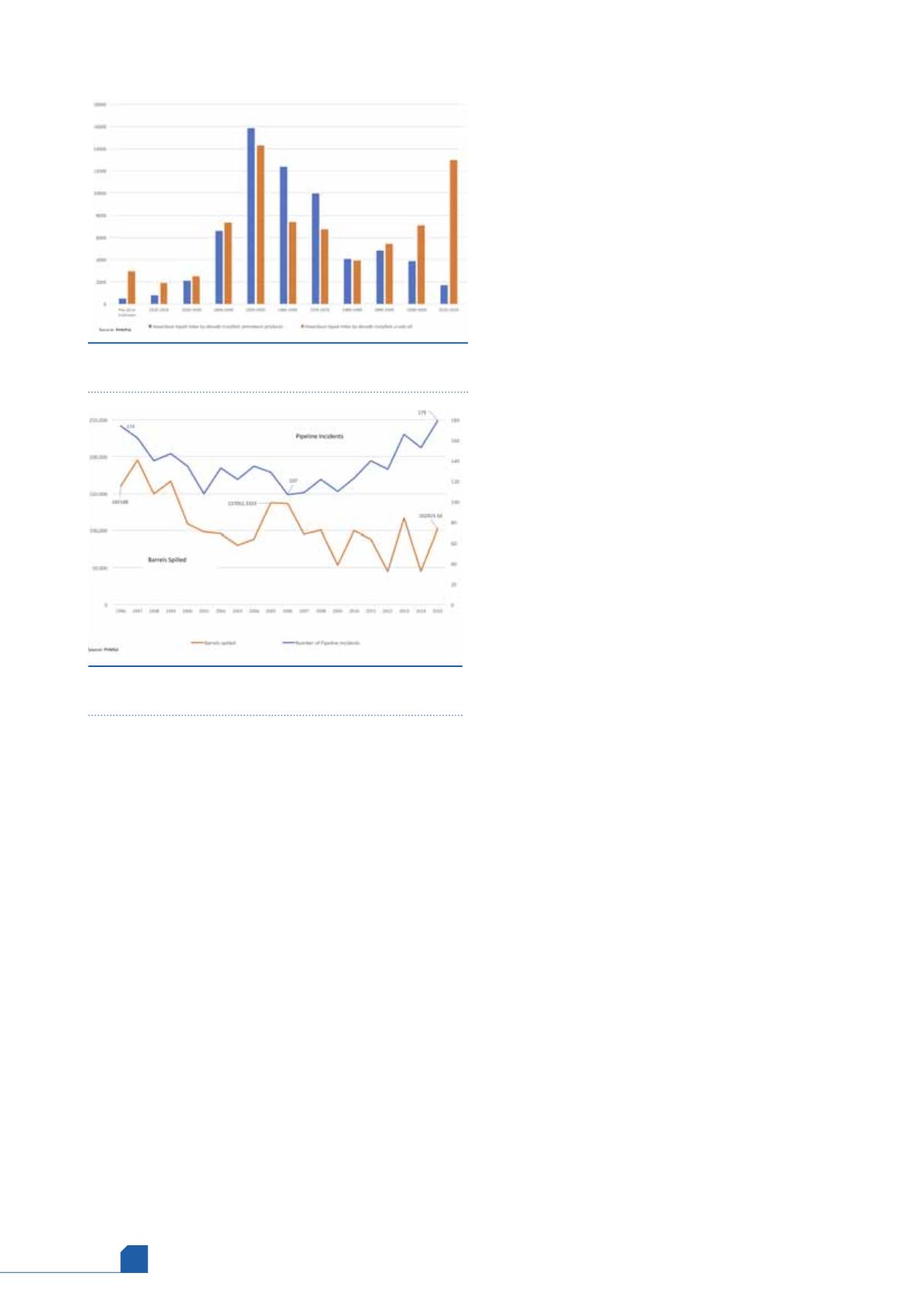
March
2017
HYDROCARBON
ENGINEERING
22
in crude by rail resulted in a number of accidents, including a
catastrophic one involving rail transport from the US to
Canada. This was the tragic Lac-Mégantic derailment in
Canada’s Quebec Province in July 2013. The train was carrying
Bakken crude to the Irving Oil refinery in New Brunswick. The
derailment and explosion killed 47 people and spilled
1.5 million gal. of crude oil.
Another derailment occurred in November 2013 at
Aliceville, Alabama. This was a derailment of 25 Bakken crude
oil tank cars, causing a fire and a spill. Another Bakken crude
train derailment occurred in December 2013 near Casselton,
North Dakota, causing an explosion and a fire that
necessitated the evacuation of thousands of people.
LTOs are, as the name suggests, lighter than conventional
heavy oils. Crude oils are complex mixtures of hydrocarbons,
and LTOs contain a higher percentage of lighter compounds
that, if fractionated out of the LTO, would be considered
similar to NGLs or condensates. Stabilising a light crude prior
to transport involves reducing the volatility and vapour
pressure of the oil by removing the gaseous fractions. This
has not been required with Bakken LTOs, and the issue
remains contentious. Some believe that since Bakken LTOs
have been the culprit in a variety of accidents, it stands to
reason that the crude should be stabilised prior to shipment.
Others point out that all crudes are flammable, and their
opinion is that LTOs are no different from other light crude
oils. An interesting hybrid view is that, yes, the LTOs
contain more volatile fractions, but since North Dakota
has no capability to handle the light ends, it would
have to export them by rail, and that this would be
even more dangerous than leaving them in the LTO.
This is not at all clear, but it does serve to illustrate the
point that people have widely ranging opinions on the
matter.
The US DOT's Pipeline and Hazardous Materials
Safety Administration (PHMSA) investigated the
derailments and in January 2014, the agency issued a
safety alert that Bakken crudes might be more
flammable than traditional heavy crude.
A number of regulatory measures followed,
covering proper classification, reporting, inspections,
training, retirement of some railcars and retrofitting of
others, and other safety measures.
In 2014, there were derailments in New Brunswick,
Pennsylvania, and Virginia.
In 2015, there were derailments in Pennsylvania,
West Virginia, Ontario, Illinois, and North Dakota.
In June 2016, a 16 car derailment spilled Bakken
crude in Washington state.
In October 2016, Royal Dutch Shell abandoned its
plans to build a 400 000 bpd oil train terminal in
Washington State.
In 2016, public officials in California rejected at
least two other train terminal proposals, one by
Valero Energy and one by Phillips 66.
Several states have proposed or enacted additional
safety measures, including Illinois, Nebraska,
Minnesota, New Jersey, California, Oregon, and
Washington. Many of these measures are pending.
Some residents would like to ban crude by rail entirely.
The regulatory horizon is far from certain, and some
rail terminal proposals have been delayed or outright
cancelled.
After two years of low oil prices, however, some of
the risk has been reduced because of the drop in US
crude production, which fell by approximately
568 000 bpd in 2016. However, as noted, the
production decline has recently reversed. Foreign
crude imports have risen in response, carried chiefly by
pipeline and tanker.
The huge surge in crude transported by rail brought a
number of tragic accidents. It is likely that new safety
measures will require attention to all elements: the cargo,
the railcars, the infrastructure, and the way the trains are
operated. Several safety measures are now proposed
and/or being enacted, but many states are dissatisfied,
and they are planning measures of their own.
The combination of increased experience and
safety regulations with reduced oil in transit is almost
certain to reduce derailments in the future, and to
reduce the damage and potential loss of life when they
do occur. But most forecasts for 2017 now look to
higher prices and a resurgence in US crude production.
Depending on where the production is located, it is
possible that demand for oil transport by rail will rise
once again.
Figure 15.
Pipeline incidents have risen, but barrels
spilled have declined.
Figure 14.
US pipelines: miles by decade installed, crude
and petroleum products, 2015.








